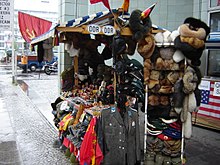Ostalgie


Ostalgie is a German term referring to nostalgia for aspects of life in East Germany. It is a portmanteau of the German words Nostalgie (nostalgia) and Ost (east). Its anglicised equivalent, ostalgia (rhyming with "nostalgia"), is also sometimes used.
The term (along with the phrase "Soviet chic") is also occasionally used to refer to nostalgia for life under the socialist system in other former Eastern Bloc countries, such as Slovakia, the Czech Republic, Hungary, and Poland. As with nostalgia for the Soviet Union, there are various motivations, whether ideology, nationalism, wistfulness for a lost sense of social status or stability, or even aesthetics or irony.
History
After the fall of the Berlin Wall in 1989 and the German reunification that followed a year later, many of the symbols of the German Democratic Republic were swept away. Almost all GDR brands (DDR in German) of products disappeared from the stores and were replaced by Western products. However, after some time most of the Eastern Germans began to miss more or less aspects of their former lives (like culture or the known brand marks). Ostalgie particularly refers to the nostalgia for aspects of regular daily life and culture in the former GDR, which disappeared after reunification.[1]
Indeed, ostalgie could be inspired by the longing of the Ossis (German for "Easterners", a term for former GDR citizens) for the social system and the sense of community of the GDR. When the renowned West-German magazine Der Spiegel asked former GDR-inhabitants whether the GDR "had more good sides than bad sides", 57% of them answered yes. To the statement of the interviewing journalist that "GDR inhabitants did not have the freedom to travel wherever they wanted", Germans replied that "present-day low-wage workers do not have that freedom either".[2]
The term was coined by the East German cabaret artist Uwe Steimle in 1992.[3]
Manifestations


Many businesses in Germany cater to those who feel Ostalgie and have begun providing them with artifacts that remind them of life under the GDR; artifacts that imitate the old ones. Available again are brands of East German foodstuffs, old state television programmes on video tape and DVD, and the previously widespread Wartburg and Trabant cars. In addition, life in the GDR has been the subject of several films, including Leander Haußmann's Sonnenallee (1999), Wolfgang Becker's internationally successful Good Bye, Lenin! (2003), Carsten Fiebeler's Kleinruppin forever (2004).
Those seeking the preservation of East German culture banded together to save the "Eastern Crosswalk Man" (Ost-Ampelmännchen), an illuminated depiction of a man wearing a "perky", "cheerful" and potentially "petit bourgeois" hat (inspired by a summer photo of Erich Honecker in a straw hat)[4] in crosswalk lights.[5] Many German cities in and near the former East German border, including Berlin, Lübeck and Erfurt, still retain the use of the Ampelmännchen at all or some pedestrian crossings due to its cultural relevance, and many souvenirs sold in East Germany and in Berlin make use of the icon.
See also
- Ampelmännchen: the waiting/walking man used in East German pedestrian traffic lights, which became a distinctive mascot for the Ostalgie movement
- Culture of the German Democratic Republic
- DDR Museum, Berlin has exhibitions on life in East Germany and extensive collections of Ostalgie items.
- Die anderen Bands
- Good Bye, Lenin!: A satirical film involving a post-reunification deception. (2002)
- Go Trabi Go: an early post-unification comedy film in which an East German family go on their first holiday in the West in their Trabant 601 (1991).
- Net shopping bag: The ubiquitous DDR Einkaufsnetz is now a retro fashion item.[6][7]
- Ostrock
- Sonnenallee: Film that has been accused of "glorifying" the GDR (1999)
- Trabant: East German automobile produced until 1991; for some, an icon of East Germany.
- Vita Cola: an example of a product revived by Ostalgie
- Yugo-nostalgia: a similar phenomenon in the former Yugoslavia
Books
- Banchelli, Eva: Taste the East: Linguaggi e forme dell'Ostalgie, Sestante Edizioni, Bergamo 2006, ISBN 88-87445-92-3.
- Banchelli, Eva: Ostalgie: eine vorläufige Bilanz, in Fabrizio Cambi (Hg.): Gedächtnis und Identitat. Die deutsche Literatur der Wiedervereinigung, Würzburg, Koenigshausen & Neumann, 2008, pp. 57–68.
- Berdahl, Daphne: On the Social Life of Postsocialism: Memory, Consumption, Germany (2009)
- Rota, Andrea: Testi pubblicitari ostalgici: una breve analisi semiotica, In Linguistica e filologia 24/2007, pp. 137–152, ISSN|1594–6517.
- Pence, Katherine and Paul Betts. Socialist Modern: East German Everyday Culture and Politics, Ann Arbor: University of Michigan Press, 2008
References
- ^ See, for instance Daphne Berdahl, "Ostalgie for the Present: Memory, Longing and East German Things" Ethnos, 1999
- ^ Julia Bonstein, "Homesick for a Dictatorship", in: Der Spiegel, 27/2009
- ^ "Ostalgiker Uwe Steimle bezeichnet sich als Kleinbürger". Hannoversche Allgemeine Zeitung (in German). 12 October 2012. Retrieved 16 January 2016.
- ^ "East Germany's iconic traffic man turns 50". The Local. 13 October 2013. Retrieved 18 May 2014.
- ^ Williams, Carol J. (April 28, 1999), "Quaint Crosswalk Symbol Starts a German Movement", Los Angeles Times,
He's dorky and thought a bit sexist, but 'Ossie' endures as a sign that not all things East should go kaput.
- ^ Wiebrecht V., Skuppin, R. (2005) in Tagesspiegel. Aus der Mode, aus dem Sinn Das Einkaufsnetz (in German). (Accessed: 4 December 2016)
- ^ Keseling, Uta (2010). Der Stoff, aus dem die DDR war, kehrt zurück in Berliner Morgenpost (in German).(Accessed: 4 December 2016)
External links
- "Ostalgie", post from The New York Times
- "Ostalgie" discussion on H-German
- Kristen R. Ghodsee, "Red Nostalgia? Communism, Women's Emancipation, and Economic Transformation in Bulgaria."
